October 10th, 2014
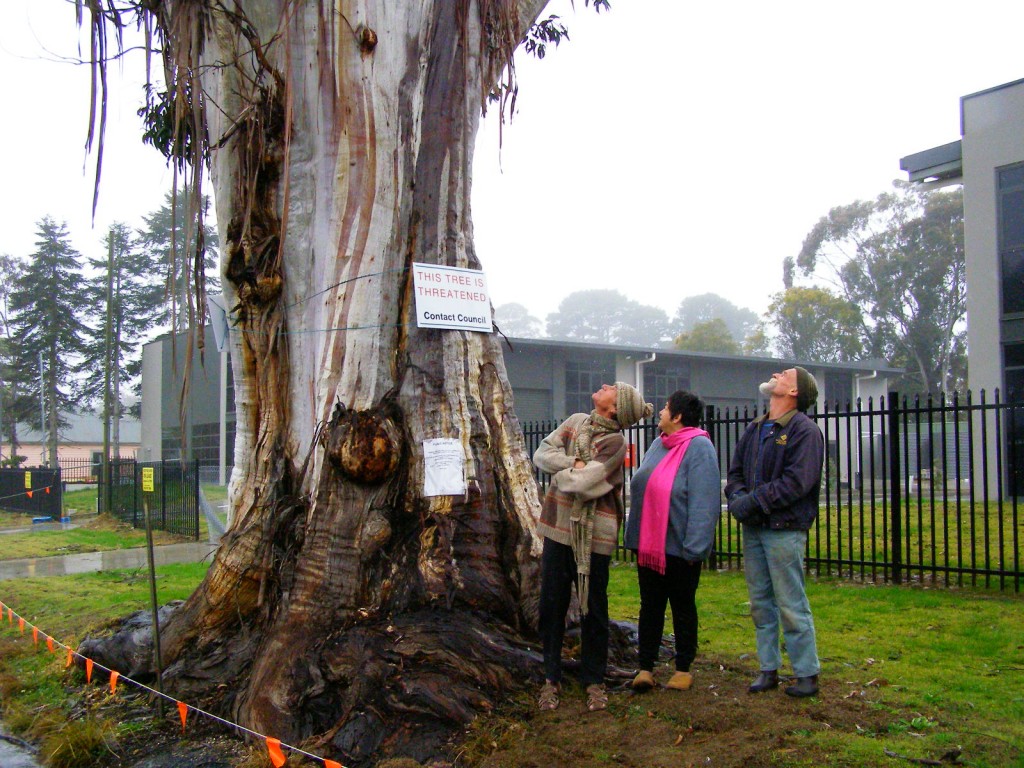 Katoomba residents Maureen and Peter Toy with Glenn Humphreys (right) marvel at Katoomba’s largest native tree
[Photo © Friends of Atlas, 20140907, click image to enlarge] Katoomba residents Maureen and Peter Toy with Glenn Humphreys (right) marvel at Katoomba’s largest native tree
[Photo © Friends of Atlas, 20140907, click image to enlarge]
.
Residents of the Blue Mountains, Maureen and Peter Toy, were shocked to learn last month about an arbitrary claim for this magnificent tree (pictured) to be killed for what they consider can be no rational reason.
According to advice that the Toys received from local conservation consultancy The Habitat Advocate, this large Blue Mountains Ash (Eucalyptus oreades) is a native tree only found in the Upper Blue Mountains. This particular specimen probably dates to 19th Century colonial settlement in Australia.
Maureen says “It is a beautiful and rare specimen and Blue Mountains folk are fortunate that we have such a significant tree still growing right by Megalong Street in now an increasingly industrialised part of Katoomba.”
Over the many decades, this great tree has withstood fierce windstorms, bushfires, road-widening right up to its trunk and industrial development all around it. With a canopy about 40 metres high and a trunk girth of over 5 metres, the tree has become a recognised icon and reference point in the area. It is home to a flock of sulphur-crested cockatoos.
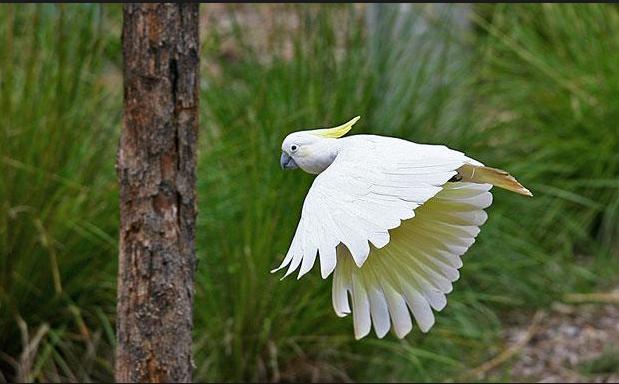 Sulphur-crested Cockatoo (Cacatua galerita)
These character parrots may be of ‘Least Concern’ to IUCN, but to the clan of cockies habitating Atlas, this is their home.
[Source: Zoos Victoria, ^http://www.zoo.org.au/healesville/animals/sulphur-crested-cockatoo] Sulphur-crested Cockatoo (Cacatua galerita)
These character parrots may be of ‘Least Concern’ to IUCN, but to the clan of cockies habitating Atlas, this is their home.
[Source: Zoos Victoria, ^http://www.zoo.org.au/healesville/animals/sulphur-crested-cockatoo]
.
Maureen affectionately calls the tree, ‘Atlas’, after the Greek God, for its towering size and for being so enduring. There is no other quite like it perhaps throughout the world renown Blue Mountains World Heritage Area.
Peter can’t understand why the tree is not on Council’s Significant Tree Register or why anyone would want to harm it. The tree is on community verge land and for the past few years there has been an industrial development constructed behind it. Peter and Maureen are vehemently opposed to any further harm being inflicted upon the tree and they have lodged a protest with council.
Several others in the local community have sided with the Toys and together have formed a local group ‘Friends of Atlas’ determined to protect the tree. Peter is looking to start a petition to garner local community recognition and support to protect the tree. He says “it is early days but he is ready for a sustained fight.”
A spokesperson from Blue Mountains (city?) Council has confirmed that the tree is situated on ‘Community Land‘ on the verdant verge strip between the street and the new industrial development at number 59 Megalong Street. The tree and its canopy and root system is not on private land, but on Community Land. Council has a duty as the community-delegated custodian of all community lands throughout the Blue Mountains Local Government Area. Council does not ‘own’ the tree per se, rather Council acts as the responsible custodian of this significant tree.
Council has stipulated in its development consent conditions for the adjoining industrial development application since 2010 that the tree must not be harmed by the current development activity.
But Peter disagrees. He says “guttering has been dug right into the tree roots system and just a month ago the developer had a bobcat grade the topsoil and roots around the tree for an entire day!.”
Council’s spokesperson says that council has not received any request for the tree to be destroyed.
A battle to save the tree is set to ensue.
.
Further Reading:
.
[1] Campaign Facebook Page: ^https://www.facebook.com/friendsofatlas
.
[2] Greater Blue Mountains World Heritage Area, ^http://whc.unesco.org/en/list/917
.
[3] Blue Mountains (city?) Council’s promotional tourism hypocrisy (or ‘greenwashing‘): ”
<<The Greater Blue Mountains World Heritage Area only exists today because of a 70-year campaign by conservationists to achieve a chain of reserves across the region. This culminated in the year 2000 with the acceptance of 10,000 square kilometres of wild bushland onto the World Heritage list – the ‘best of the best’.>>
Source: Blue Mountains (city?) Council, ^http://www.greaterbluemountainsdrive.com.au/
.
…70 years hence, this is the same reason why conservationists ‘Friends of Atlas’ have started a campaign. Atlas is the “best of the best”.
.
Leave a Reply
You must be logged in to post a comment.
October 8th, 2014
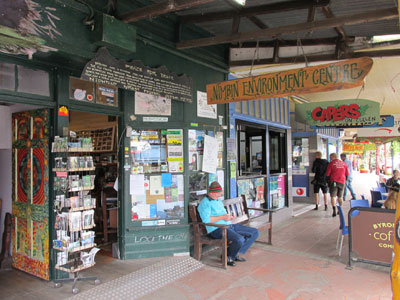 Nimbin Environment Centre
Cullen Street (main street), Nimbin, New South Wales, Australia
[Source: Nimbin Environment Centre,
^http://www.nimbincommunity.org.au/index.php/environment-centre] Nimbin Environment Centre
Cullen Street (main street), Nimbin, New South Wales, Australia
[Source: Nimbin Environment Centre,
^http://www.nimbincommunity.org.au/index.php/environment-centre]
.
Amongst other worthy places, there are two that are special and worth a visit when exploring the Northern Rivers Region of New South Wales. Walk the ‘Wonga Walk’ (5.4km) beneath the rainforest canopy in Dorrigo National Park and stroll through the counterculture village of Nimbin calling into the Nimbin Environment Centre.
.
Dorrigo Plateau Country
.
Perhaps the tallest remaining rainforest trees survive in the natural ecology and splendour in Dorrigo National Park, part of originally Gumbaynggirr Aboriginal Country, and currently one of eight groups of World Heritage protected areas in the Gondwana Rainforests of Australia..
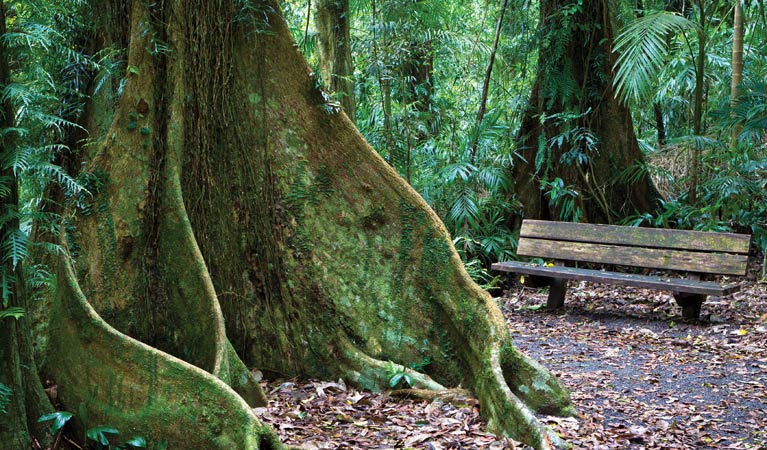 Yellow carabeen (Sloanea woollsii)
Found growing naturally up to 55 metres tall along the Wonga Walk in Dorrigo National Park
[Source: NSW National Parks and Wildlife Service,
^http://www.nationalparks.nsw.gov.au/dorrigo-national-park/wonga-walk/walking/visual-tour] Yellow carabeen (Sloanea woollsii)
Found growing naturally up to 55 metres tall along the Wonga Walk in Dorrigo National Park
[Source: NSW National Parks and Wildlife Service,
^http://www.nationalparks.nsw.gov.au/dorrigo-national-park/wonga-walk/walking/visual-tour]
.
Nimbin
.
The village of Nimbin is many miles from Dorrigo, but that doesn’t matter. Nimbin’s spirit is similar from that gained on the rainforest walk.
Perhaps one of the most respectful and communicative messages of any community in Australia is that of Nimbin’s, which draws upon the values of local Aboriginal elders, and shared by Nimbin’s close-knit local mix:
“We belong this country
We look after this country
Don’t do wrong around here this country
We don’t harm this country here
We belong to it this country”
~ Bundjulung Elders.
.

The Nimbin Environment Centre is a voluntary non-profit organisation. It’s website reads: our history is rooted in the successful battles which saved Terania Creek and The NightCap Forest. We are very conscious of our continuous role as custodians of this land, hand in hand with its first people: The Bundjalung nation. We receive no funding from State or Federal Governments. This empowers us to be fearless in our work to defend, protect, preserve and enhance the environment.
We read this and reflect upon our crews visit in October 2013, and upon the subsequent town fire of the 13th August 2014 which tragically struck at the heart of Nimbin.
We remember and preserve some memories for those who have contributed to the Magic of Nimbin since the Aquarius Festival of 1973 which has since celebrated the hope of ‘Counter Culture’.
We offer the following images of a Nimbin morning taken by our editor paying an overnight visit to Nimbin 23rd – 24th October 2013. All images are copyright free in the public domain as we consider appropriate. Nimbin sets an example of community respect to the world. For each image click to enlarge.
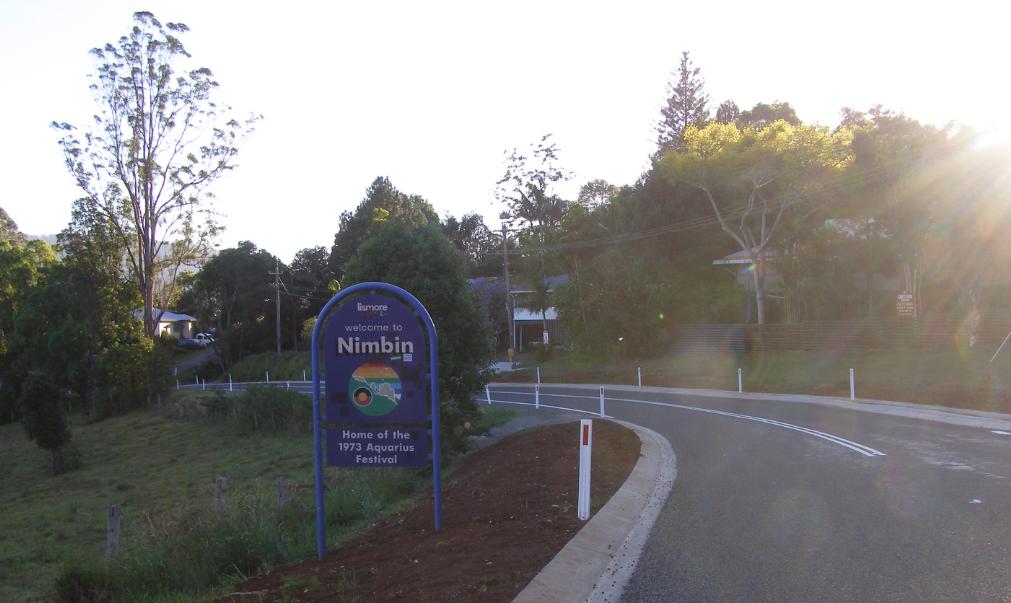
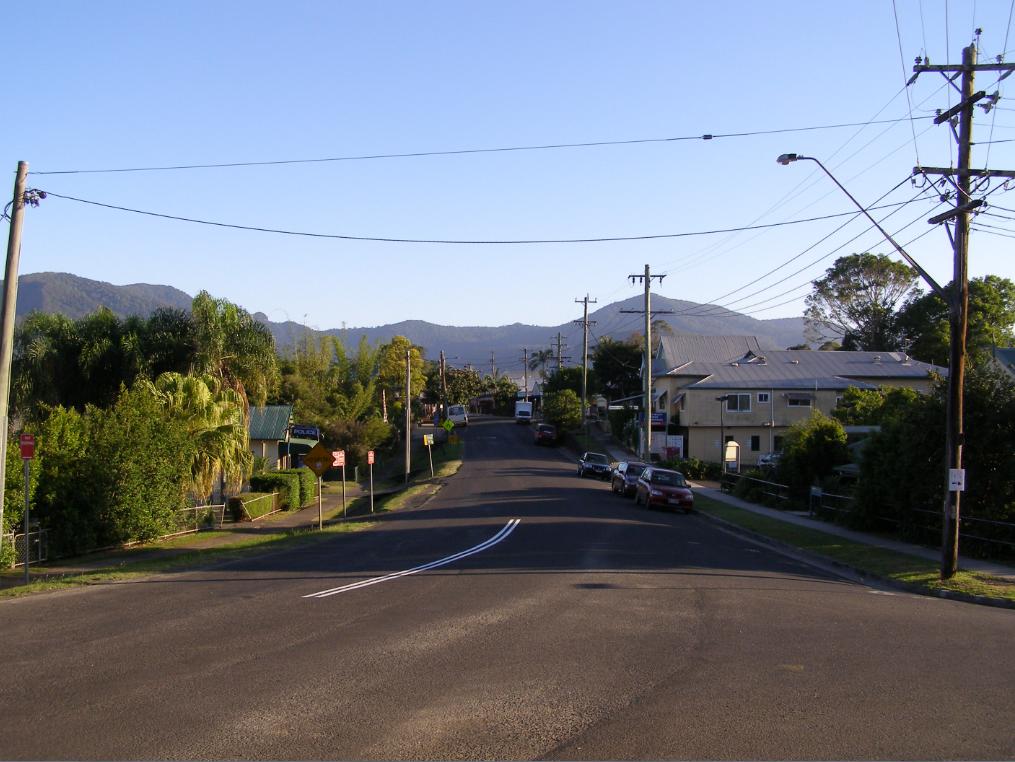
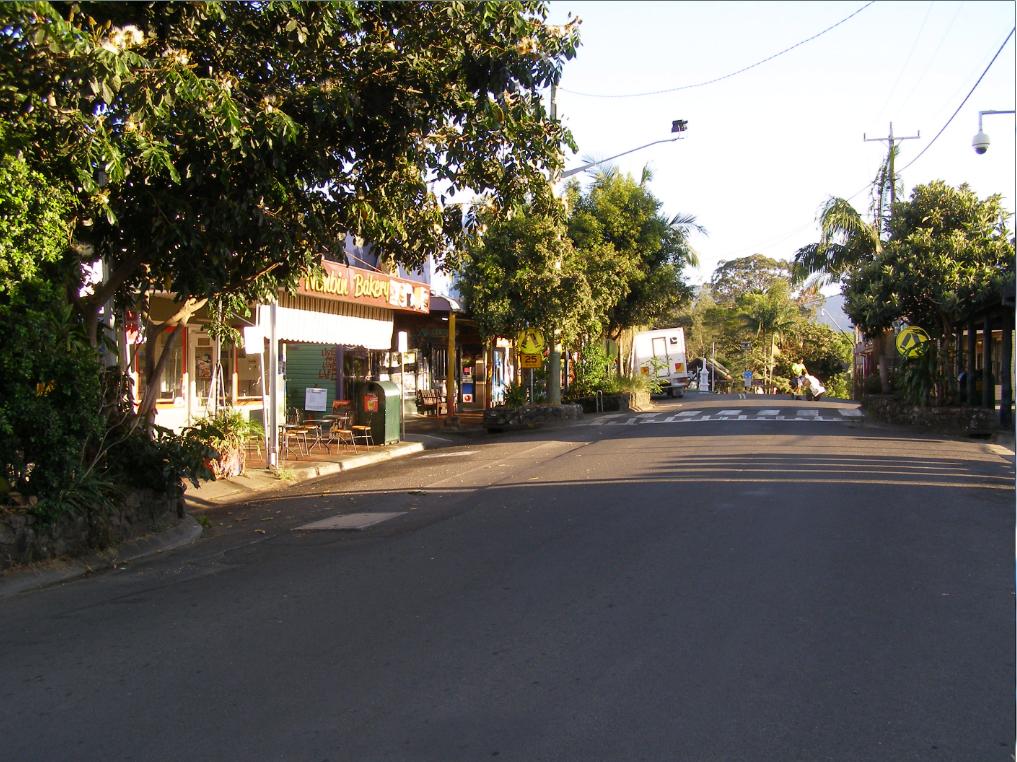
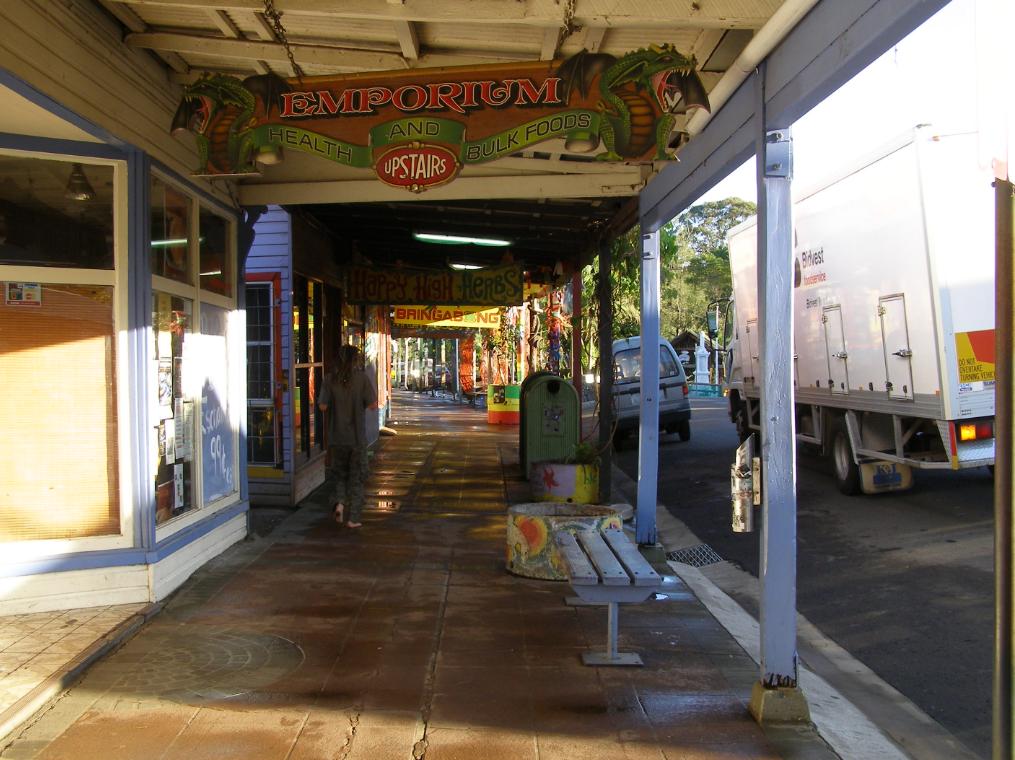
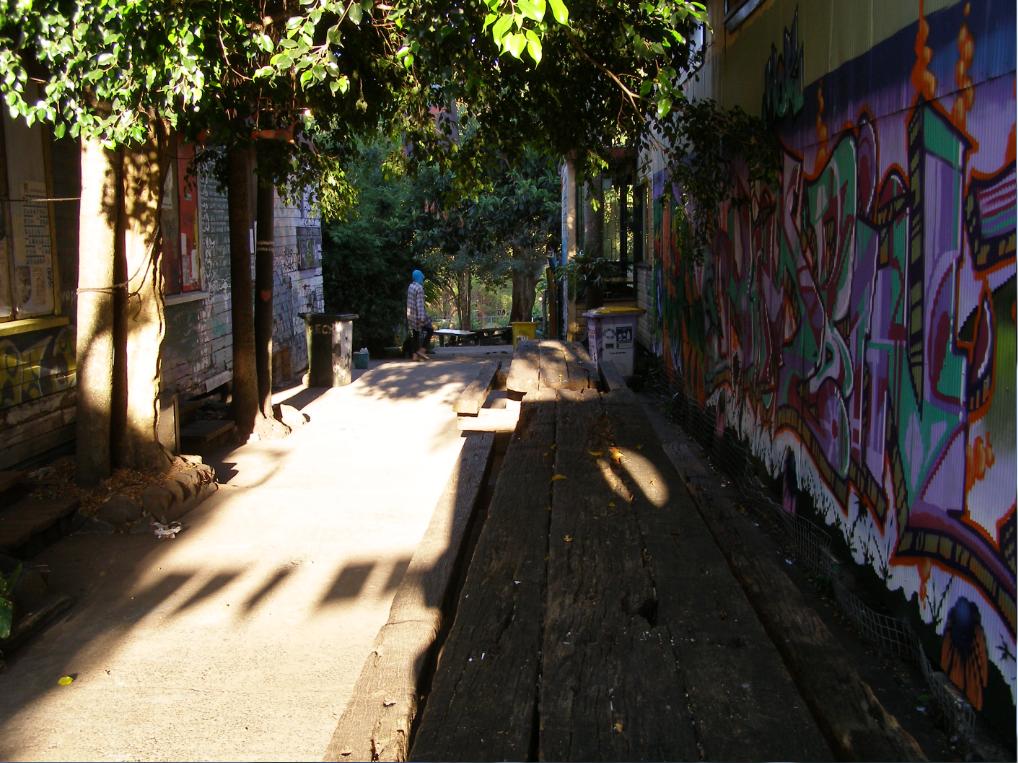
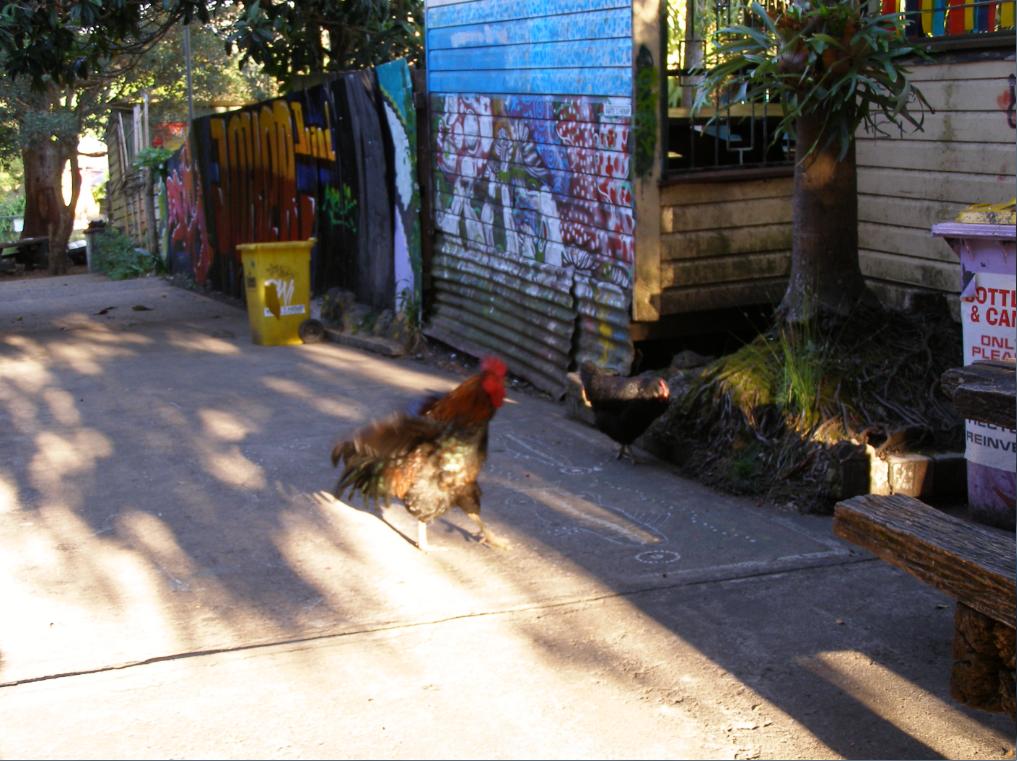

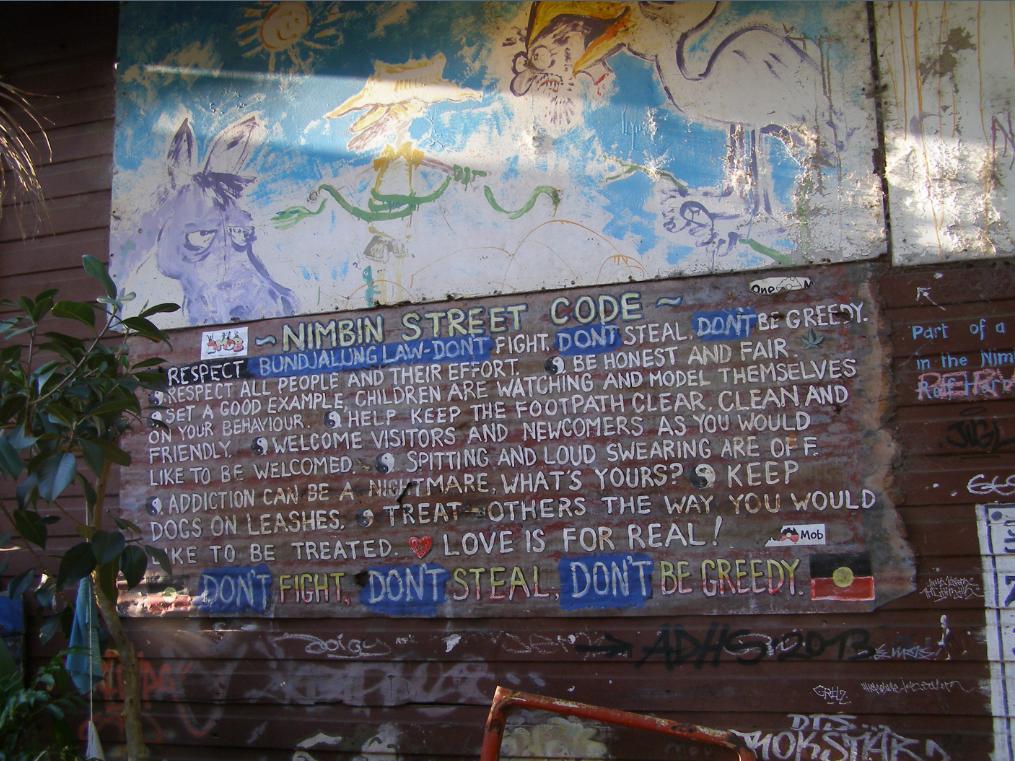
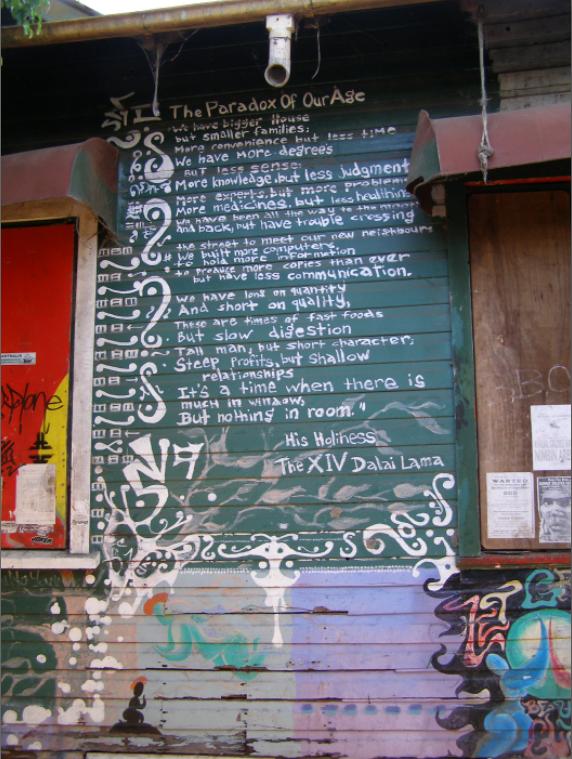
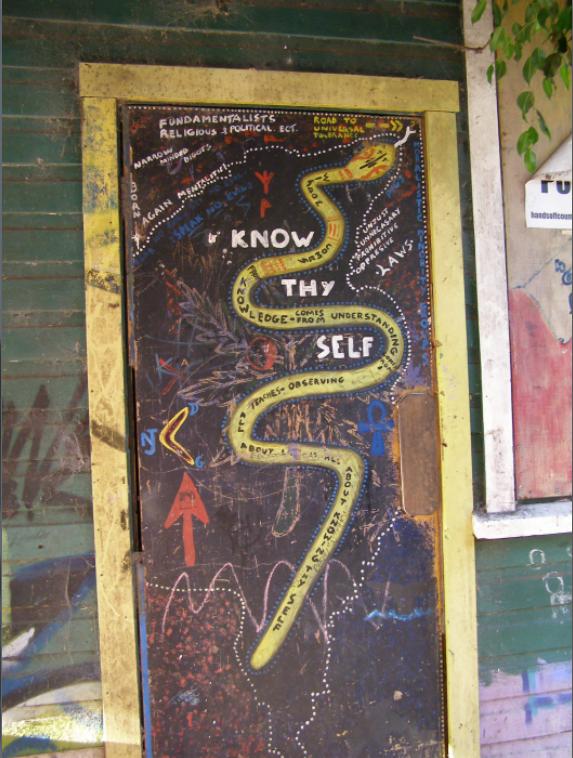

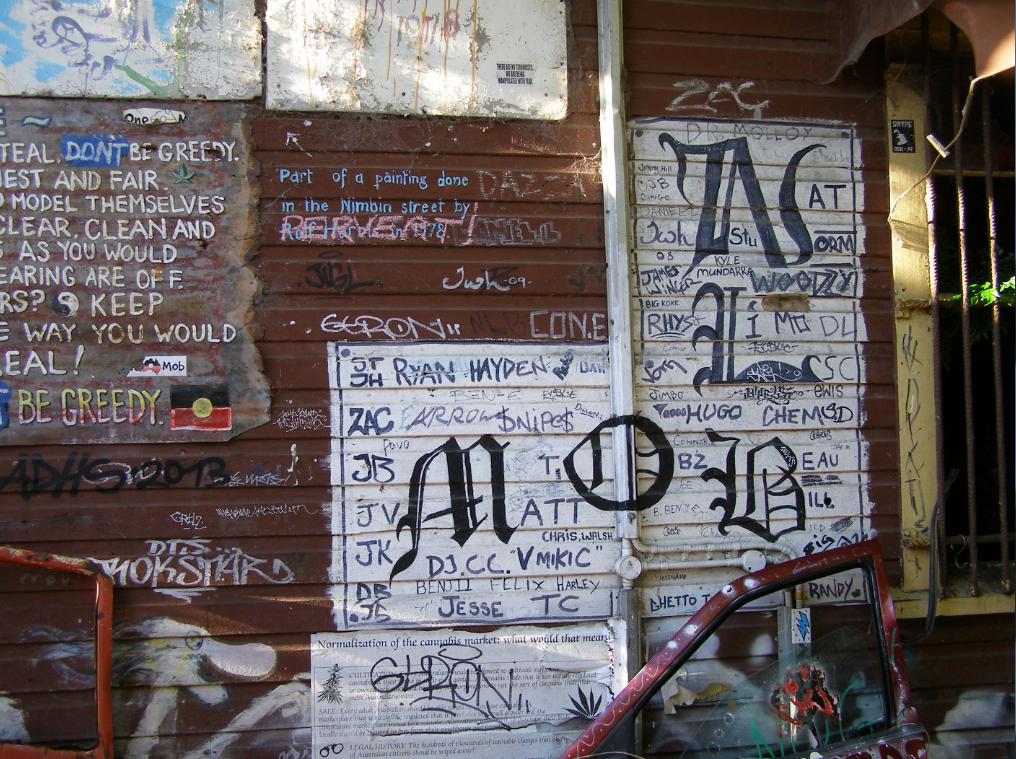
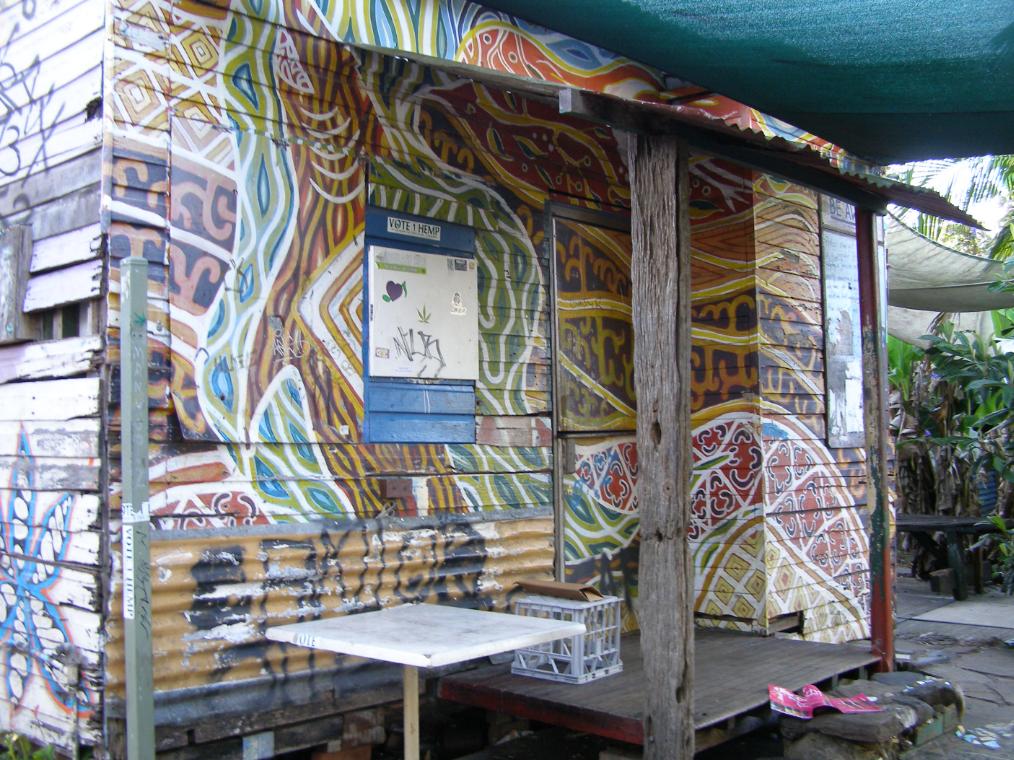
.
Further Reading:
.
[1] Nimbin Environment Centre, ^http://www.nimbincommunity.org.au/index.php/environment-centre
.
[2] Nimbin Museum, ^http://nimbinmuseum.com/
.
[3] Friends of Gondwana Rainforest, ^http://gondwanarainforest.org/australia
.
[4] ‘Once Upon a Time in Nimbin‘, a traveller’s account, 20120703, ^http://www.soulfoodtraveller.com/2012/07/once-upon-timein-nimbin.html
.
[5] Rainforest Publishing, owned by Hugh and Nan Nicholson, The Chandon, ^http://www.rainforestpublishing.com.au
.
Leave a Reply
You must be logged in to post a comment.
July 26th, 2014
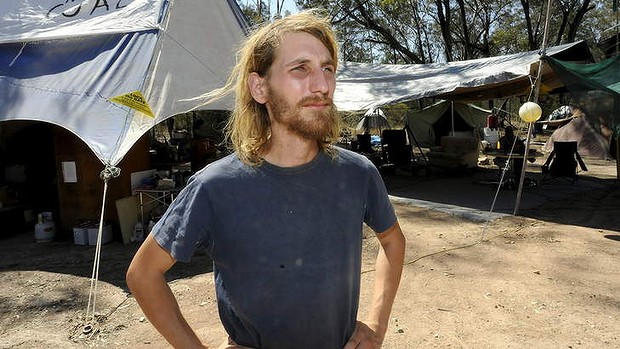 Environmental Protestor, Jonathon Moylan,
who put himself on the line to save Leard State Forest from greedy Whitehaven Coal
set to bulldoze koala habitat into extinction
[Source: ‘Time to flex shareholder muscle’, 20130119, Canberra Times,
^http://www.canberratimes.com.au/federal-politics/time-to-flex-shareholder-muscle-20130118-2cz10.html Environmental Protestor, Jonathon Moylan,
who put himself on the line to save Leard State Forest from greedy Whitehaven Coal
set to bulldoze koala habitat into extinction
[Source: ‘Time to flex shareholder muscle’, 20130119, Canberra Times,
^http://www.canberratimes.com.au/federal-politics/time-to-flex-shareholder-muscle-20130118-2cz10.html
It was not Whitehaven Coal, but the Australian corporate regulator, Australian Securities and Investment Commission (ASIC) who tried to imprison a civil protester to jail in defence of market gambling.
 ASIC Chairman Greg Medcraft ASIC Chairman Greg Medcraft
<< Jonathan Moylan, 26, was today sentenced to 1 year 8 months imprisonment, but subject to release immediately on a 2 year good behaviour bond following a hearing at the Supreme Court in Sydney. 150 supporters held a vigil in support of Moylan outside the court.
ASIC used Orwellian language of defending ‘mum and dad’ investors, disguising the fact that mining companies like Whitehaven Coal are predominantly foreign-owned.
The miners, along with the superannuation industry and the ”big four” banks, have done a remarkable job popularising the idea that all Australians own a share of all companies thanks to their super. By that logic, anything that hurts any company is ”bad” for Aussie mums and dads. And that is, of course, the impression that the corporate and political spin doctors are trying to create. But what about when the courts tell the banks they cannot impose punitive charges; is that bad for mum and dad investors as well?
The hoax press release by Jonathan Moylan was designed to highlight the fact that the ANZ Bank says it doesn’t lend money to environmentally harmful projects when in fact it does so regularly.
While the hoax’s impact on ”mum and dad” shareholders was massively exaggerated, the potential power of these shareholders is systematically underestimated. While few Australians own anywhere near enough shares to notice the impact of the daily wobbles in share prices on our incomes, together we all own enough to make most companies do exactly what we want. The challenge is to focus that power through well-crafted motions and to ensure the super funds that manage our money on our behalf are willing to support those motions. The Australasian Centre for Corporate Responsibility will hopefully play an important role in achieving both.
Dr Richard Denniss is executive director of The Australia Institute, a Canberra-based think tank.
“The determination of the movement to protect the Maules Creek community, farmland and Traditional Owners is only getting stronger and I’m confident that determination won’t be broken,” said Jonathan Moylan.
“In 30 years time our children will look back on us and we will have to answer to them,” he said.
Rick Laird, farmer from Maules Creek whose family has farmed in the district for over 150 years, travelled to Sydney to support Jonathan Moylan.
“Jono is a young man of great principle and conviction and we are incredibly grateful for the stand he took to support Maules Creek. We remain determined to fight off Whitehaven’s coal mine to protect Maules Creek and Leard State Forest,” said Rick Laird.
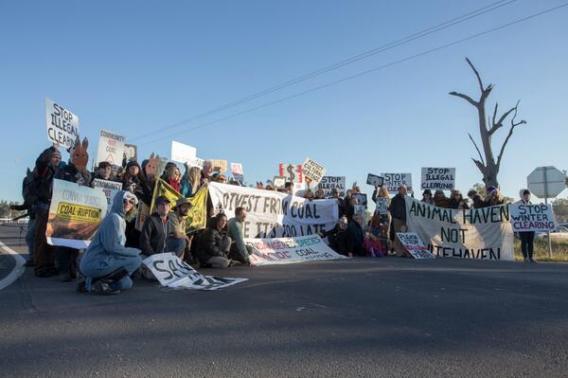
“To most people ANZ is just a bank, but to our community at Maules Creek their loan to Whitehaven Coal threatens to put an end to 150 years of farming in the region.”
“We’ve been fighting this mine for years but what Jono did means the world knows what is happening to Maules Creek farms and the Leard State Forest,” said Rick Laird.
In January 2013 Jonathan Moylan issued a press release on ANZ letterhead saying the bank had withdrawn its $1.2 billion loan facility from Whitehaven’s Maules Creek Coal Project on environmental and ethical grounds. Whitehaven’s share price temporarily fell before quickly recovering.
Moylan was charged under section 1041E of the Corporations Act by ASIC, pertaining to the making of false or misleading statements.
High-resolution photographs are available at: https://www.flickr.com/photos/standwithjono/sets/72157645492344138/
Background
ANZ provides a $1.2 billion loan facility to Whitehaven Coal, primarily intended to develop the Maules Creek Coal Project. The Maules Creek Coal Project is a new open-cut coal mine being developed in Leard State Forest and adjacent farm land near Maules Creek in north west NSW.
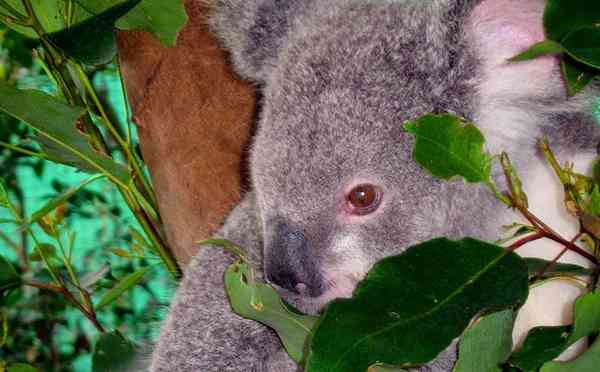
On the day of the hoax, Whitehaven Coal’s (WHC) share price dropped from $3.52 to $3.21 before a trading halt, and bounced back to $3.53 within an hour of trading resuming. Since January 2013, Whitehaven’s share price has plummeted in the face of the slumping global coal price, closing at $1.68 yesterday.
Leard State Forest is located between Narrabri and Boggabri, it includes the most extensive and intact stands of the nationally-listed and critically endangered Box-Gum Woodland remaining on the Australian continent. The forest is home to 396 species of plants and animals and includes habitat for 34 threatened species and several endangered ecological communities.
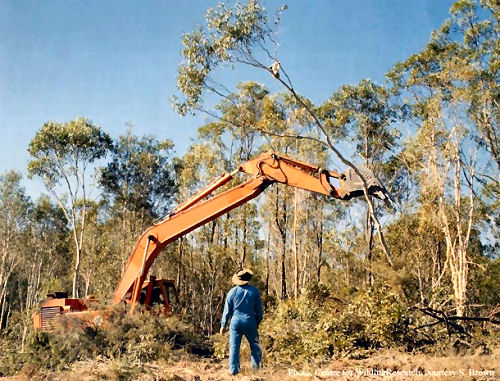
The Maules Creek Coal Project is approved to extract up to 13 million tonnes of coal annually, and is estimated to produce 30 million tonnes of CO2 equivalent per year. The mine is expected to operate for more than 30 years. The coal will be railed from the mine in north west NSW to the port of Newcastle for export. The coal mine project boundary is approximately 5 kilometres from the Maules Creek township. >>
.
[Source: ‘Jonathan Moylan Sentenced to 2yr good behaviour bond by Supreme Court’, 20140725, ^http://www.standwithjono.org/]
.
Leave a Reply
You must be logged in to post a comment.
July 6th, 2014
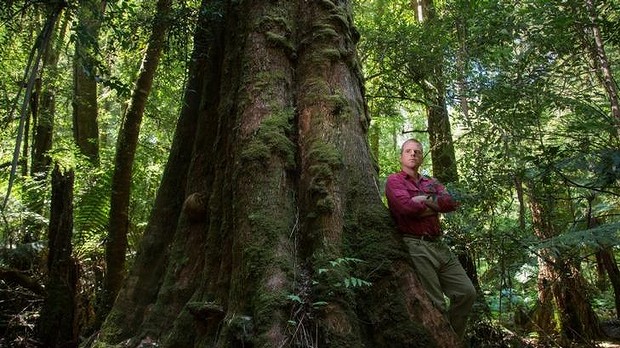 Vica Bayley, Tasmanian campaign manager for the Wilderness Society in disputed World Heritage listed forest in the Styx Valley in southern Tasmania. Photo © Peter Mathew. [Source: ‘Senate puts weight behind push to retain Tasmania forests’ World Heritage status, 20140515, by Andrew Darby, Sydney Morning Herald, ^http://www.smh.com.au/federal-politics/political-news/senate-puts-weight-behind-push-to-retain-tasmania-forests-world-heritage-status-20140515-zrdqi.html] Vica Bayley, Tasmanian campaign manager for the Wilderness Society in disputed World Heritage listed forest in the Styx Valley in southern Tasmania. Photo © Peter Mathew. [Source: ‘Senate puts weight behind push to retain Tasmania forests’ World Heritage status, 20140515, by Andrew Darby, Sydney Morning Herald, ^http://www.smh.com.au/federal-politics/political-news/senate-puts-weight-behind-push-to-retain-tasmania-forests-world-heritage-status-20140515-zrdqi.html]
.
“It took the World Heritage Committee less than 8 minutes to unanimously reject this shameful Australian Government proposal to delist 74,000 hectares from the Tasmanian World Heritage Area. It is a stunning victory for World Heritage!
Thank you to those who understood the value and the importance of protecting our wild places.”
~ Keith Muir, Colong Foundation for Wilderness
.
Further Reading:
.
.
Leave a Reply
You must be logged in to post a comment.
May 17th, 2014
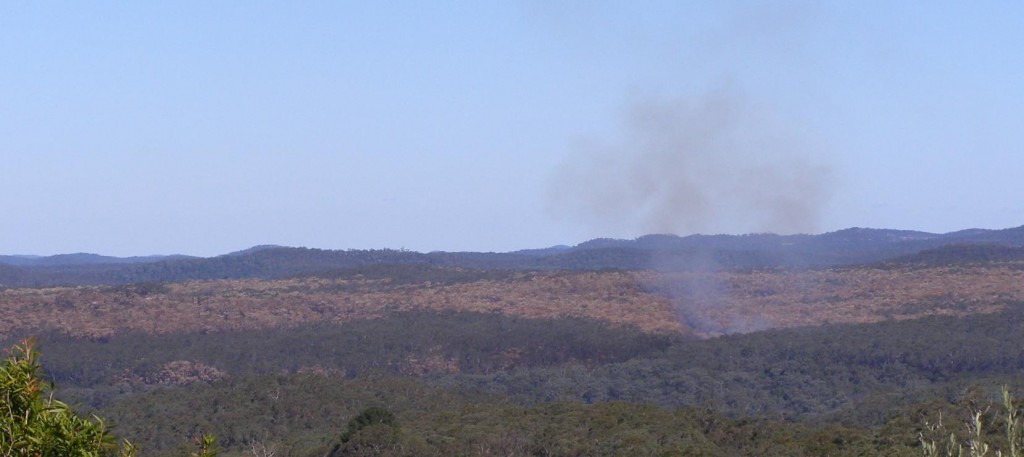 Williams Ridge crown-topping bushfire having been deliberately lit by National Parks Service 20140510
Looking south from Mona Road, Woodford, Blue Mountains with residual fire still unattended 6 days later near virgin “World Heritage fuel“.
Photo by Editor 20140516, click image to enlarge.
© under ^Creative Commons] Williams Ridge crown-topping bushfire having been deliberately lit by National Parks Service 20140510
Looking south from Mona Road, Woodford, Blue Mountains with residual fire still unattended 6 days later near virgin “World Heritage fuel“.
Photo by Editor 20140516, click image to enlarge.
© under ^Creative Commons]
While holidaying in the Megalong on the weekend of 10-11 May 2014 for my 50th, in the late morning of the 10th my wife alerted me to a large bushfire smoke cloud billowing in the Blue Mountains to our east.
Cripes! was my first thought when I looked east seeing smoke plumes billowing beyond the western escarpment in the direction of our upper Blue Mountains family home. I got out my topographic Katoomba map and my Silva compass (being a weekend bushwalker) and aligned the bushfire smoke plume to my map . The billowing smoke was scarily in line with a bearing to the upper Blue Mountains where our house was. Distance was the uncertainty.
So I immediately rang friends to check. They said the smoke was south of Woodford. It was fortunately far away from our house. But how could such a large bushfire start on a still, cold autumn day? My mind clicked – Hazard Reduction!
I recall seeing NPWS bushfire labelled vehicles parked in Katoomba the previous week. I hadn’t seen these specialised vehicles before, so this must be a NSW Government capital investment in ongoing National Park arson. Is it to sadistically drive wildlife extinctions? There has been no public announcement of such, so the sadistic strategy must be pre-conceived and signed off.
So on return to home, our house was fine and no-one was the wiser about any bushfire. The bush arson had been deliberately and “strategically” lit farther east and deep south into the Blue Mountains National Park, many kilometres from housing. The bushfire was lit by the entrusted custodians of the Blue Mountains World Heritage Area: NPWS. They call it ecological burning so suggest that burning vegetation habitat is good for it.
Down along the Great Western Highway the scorched canopy blanket become obvious south of Lawson. Unravel the map and the southern ridge is Williams Ridge from Kings Tableland east to Mount Bedford. The access is Ingar Fire Trail. This was the access route for the government bush arsonists. The gate is locked to hide the slaughter.
.
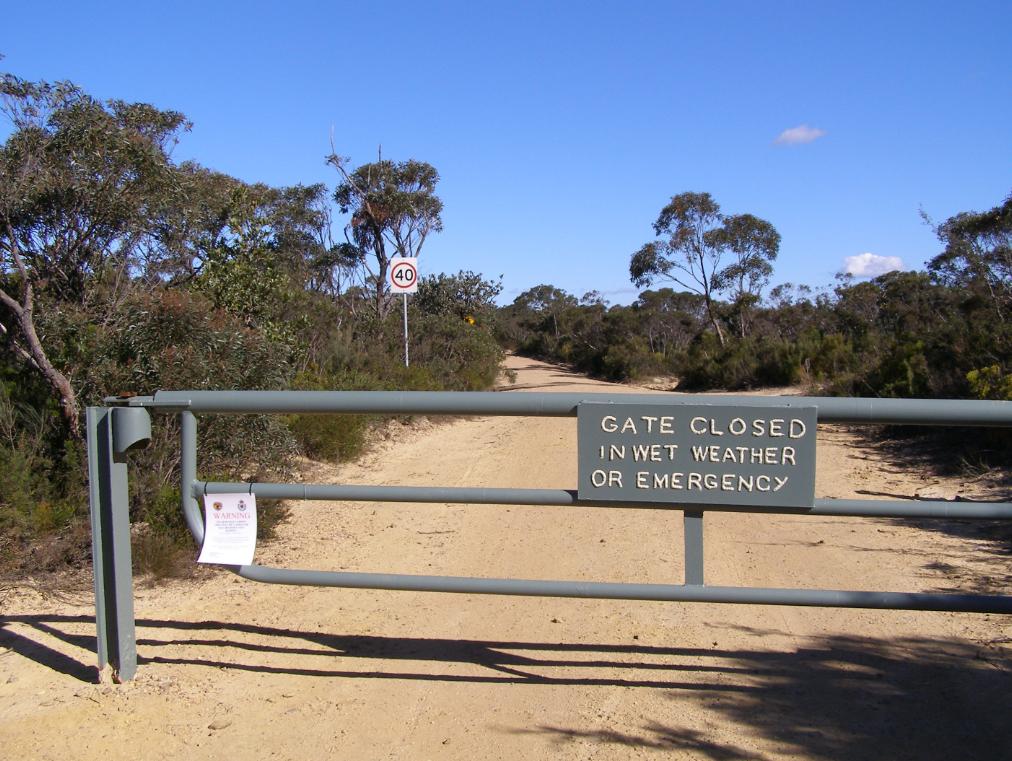 Ingar Fire Trail with locked gate on Kings Tableland, Wentworth Falls
Photo by Editor 20140516, click image to enlarge. © under ^Creative Commons] Ingar Fire Trail with locked gate on Kings Tableland, Wentworth Falls
Photo by Editor 20140516, click image to enlarge. © under ^Creative Commons]
.
Is this the new sadistic/fatalist management of National Parks and Wildlife Service? Incinerate forest habitat in Blue Mountains World in case in burns? Spend millions in exploitative tourism cost recovery? As for wildlife, what wildlife. Is this NPWS new sadistic motto for the Blue Mountains World Heritage, following the demise and exploitaton of of the Barrier Reef and Kakadu?
.
 Ingar Fire Trail with close up of locked gate on Kings Tableland, Wentworth Falls
Photo by Editor 20140516, click image to enlarge. © under ^Creative Commons] Ingar Fire Trail with close up of locked gate on Kings Tableland, Wentworth Falls
Photo by Editor 20140516, click image to enlarge. © under ^Creative Commons]
.
Burns to humans do recover in time despite the short term pain. Humans do recover from trauma in time. If trauma goes unpublished, few in the community know about what happened anyway. So it is morally acceptable then to inflict burn trauma upon ecological communities because no-one knows the wiser? Yet week after week, ecological massacre repeats like the Australian Frontier Wars. Read More: ^Aboriginal Massacres,^Australian Frontier Wars.
All the government website media release 8 May 2014 can say is a dismissive massacre as usual:.
“Smoky weekend for the Blue Mountains as 5,500 hectares of hazard reduction burning gets underway”
.
[Source: “Smoky weekend for the Blue Mountains as 5,500 hectares of hazard reduction burning gets underway”, official government media release by Susie Summers, NPWS (Environment Department so-called), 20140508, ^http://www.environment.nsw.gov.au/media/OEHMedia14050801.htm]
.\
<<NSW National Parks and Wildlife Service (NPWS) plans to take advantage of a window of favourable weather to get two major hazard reduction (HR) burns completed in the Blue Mountains this weekend. Following a wet start to the season, it has been very difficult to complete burning operations, NPWS Regional Manager Alan Henderson said.
Weather permitting the following HRs will go ahead: • Friday, 9 May – 3,000 hectare Little Crater burn, south of Glenbrook and west of the Warragamba Dam; • Saturday, 10 May – 2,500 hectare Mt Bedford burn, 3km south east of Wentworth Falls, Bullaburra and 2km south of Lawson, Hazelbrook and Woodford.
“For the safety of crews and neighbours, and to the ensure these burns are effective, they can only be undertaken when the weather is right – it cannot be too wet, cold or windy – making scheduling them very tricky,” Mr Henderson said. “The proposed burn area for the Little Crater burn is remote and bounded by the Warragamba and Nepean River to the east, Erskine Creek to the north, Big Crater Creek to the west and Erskine Range (W5 management trail) to the south.
“It will protect private property to the east of Warragamba River by reducing fuel loads to minimize the risk of wildfire spreading from Blue Mountains National Park into Warragamba and Silverdale townships.
“This is a joint operation with the Rural Fire Service (RFS) which will also help to protect Sydney Catchment Authority assets to the south east of the burn including the Warragamba dam wall and its associated structures. “There is the potential for smoke from this burn to drift towards the western and southwestern suburbs of Sydney. “Meanwhile, the 2,500 hectare Mt Bedford HR is planned to begin on Saturday (May 10) and will also be conducted in partnership with RFS. “In the interests of visitor safety, Ingar Road, Andersons Trail and Bedford Creek trail will be closed for the duration of the burn, which is designed to limit the potential for wildfire to spread west to east and impact on life and property throughout the Blue Mountains.
“Smoke will be visible between Katoomba and Springwood and smoke drift may impact the Great Western Highway, the Oaks Fire Trail and lower mountains townships. Both operations and associated closures are likely to continue for a number of days. Updates regarding National Park closures may be found on the national parks website:http://www.nationalparks.nsw.gov.au/safety/fires-and-park-closures “People with asthma or those susceptible to respiratory problems are also advised to keep clear of the immediate area or stay indoors.” You can subscribe to air quality alerts from the Office of Environment and Heritage here ^http://www.environment.nsw.gov.au/aqms/aqialerts.htm .
.
‘The NPWS has undertaken 895 hazard reduction activities covering 70,000 hectares in total,
including 160 hazard reduction burn operations for 2013-14.’
.
In 2012-13 the NPWS achieved a record 208,000 hectares in 1300 separate fuel reduction activities. This was 83% of the total hazard reduction effort for NSW, demonstrating a clear commitment by NPWS to manage fire in accordance with its Living with Fire 2012-21 strategy. [They must be proud custodians of World Heritage.]
Under the Enhanced Bushfire Management Program (Strategic Broadacre Incineration), NPWS will pursue its plan to treat an average of over 135,000 hectares per year in 800 or more planned hazard reduction activities. Achieving this will be highly dependent on the suitability of weather conditions given the narrow window of opportunity that exists in NSW for burning safely and effectively.>> .
.
[ ‘If wildlife isn’t exterminated and made locally extinct, then we have failed our purpose.’ ]
..
Eco Hazard Reduction now means starting a bushfire so hot and fierce that the entire tree crown is incinerated so that nothing can live and so that it causes a smoke plume that puts the pollution effort of industrial Sydney and its traffic to shame.
.
 Prevent Prepare Protect what? Prevent Prepare Protect what?
.
Incinerate disappearing World Heritage habitat so that timber bush properties approved for build in dumb indefensive slopes can have hope in bushfire hell? Or to hell with it, just burn the lot, like the old Blue Mountains bush firie adage: “Hazard reduce Katoomba to save Leura.” Sounds like what Queensland is doing to the Great Barrier Reef.
.
What wildlife? What habitat? What World Heritage? .
.
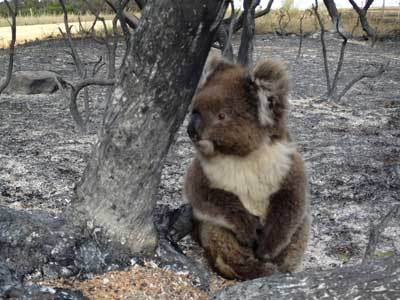 Prevent Prepare Protect what?
When a wildfire starts, they have no idea anyway. Prevent Prepare Protect what?
When a wildfire starts, they have no idea anyway.
.
Leave a Reply
You must be logged in to post a comment.
May 5th, 2014
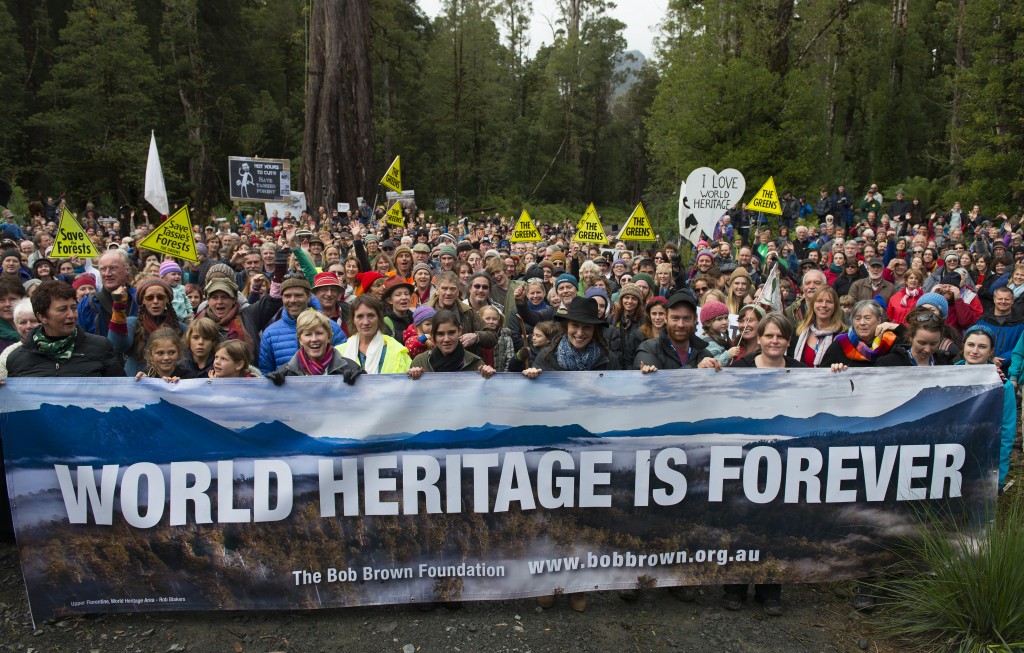 Historic rally in Tasmania’s Upper Florentine Valley, Tasmania, Sunday 20140427
Photo © Matthew Newton Historic rally in Tasmania’s Upper Florentine Valley, Tasmania, Sunday 20140427
Photo © Matthew Newton
.
Almost 2000 people have rallied today in the Upper Florentine Valley to defend World Heritage listed forests.
The Bob Brown Foundation’s Campaign Manager Jenny Weber stated, “Today’s outstanding turn out in the Upper Florentine forests clearly shows that Australians are very proud of their World Heritage forests. We are sending a strong message to UNESCO that we love our spectacular forests of outstanding universal value, and the Australian community will stand up to defend them.”
“The Australian community strongly opposes the government’s proposal to the World Heritage Committee to remove 74 000 hectares of World Heritage listed forests from the Tasmanian World Heritage Area,” Jenny Weber said.
Speakers included Australian Greens Leader Senator Christine Milne, Markets for Change CEO Peg Putt, Still Wild Still Threatened’s Miranda Gibson and Home and Away actor Lisa Gormley.

.
Further Reading:
.
[1] ^http://www.bobbrown.org.au/
.
Leave a Reply
You must be logged in to post a comment.
April 13th, 2014
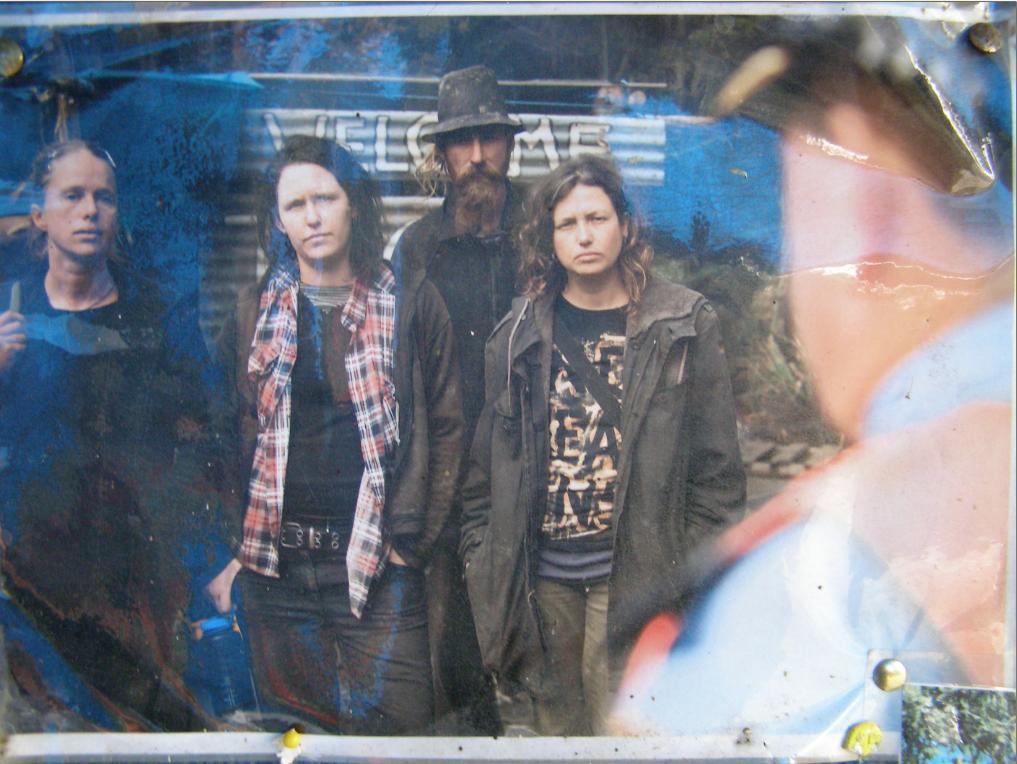 For the cause and their honour
Camp Flozza remembered For the cause and their honour
Camp Flozza remembered
.
New Tasmanian Premier Will Hodgman believes in a headline sense of “economic renewal” somehow and that his vote to power provides a Viking Mandate for him to ecologically ‘rape pillage and plunder’ Tasmania’s natural resources.
With the business community on side, the minerals council, the housing industry association, the developers, the loggers, everything is up for grabs, especially Tasmania’s old growth forests.
Logging trucks are already crossing back over Bass Strait from exile in parochial log state Queensland.
Here we go again…
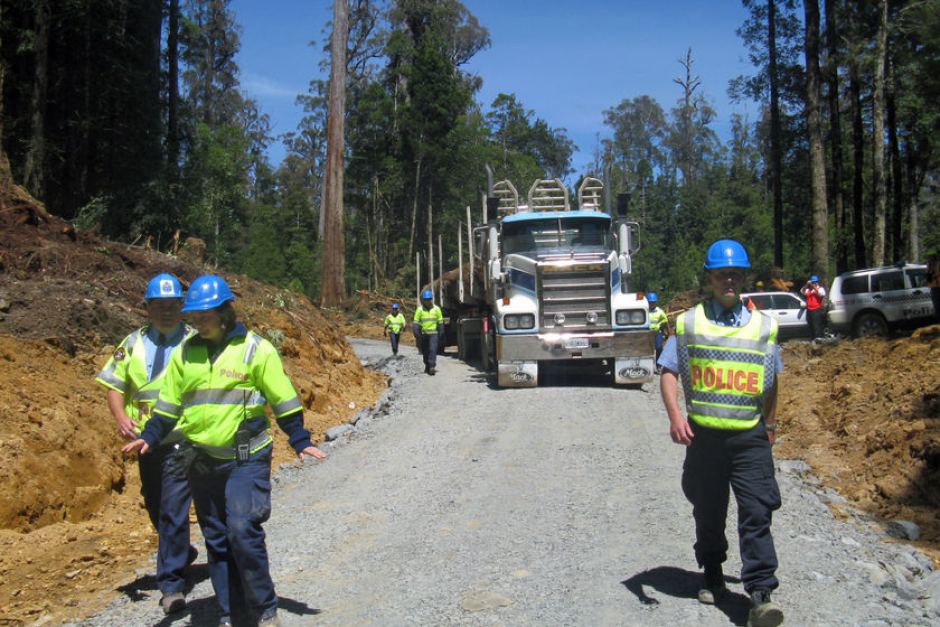 Tasmanian police escort a log truck out of the Upper Florentine Valley after a week of protests, January 2009.
[Source: ‘Protests have failed to stop the log trucks’, 20090121, ABC News,
^http://www.abc.net.au/news/2009-01-21/tasmanian-police-escort-a-log-truck-out-of-the/273180] Tasmanian police escort a log truck out of the Upper Florentine Valley after a week of protests, January 2009.
[Source: ‘Protests have failed to stop the log trucks’, 20090121, ABC News,
^http://www.abc.net.au/news/2009-01-21/tasmanian-police-escort-a-log-truck-out-of-the/273180]
.
“We are going to embrace a new way of doing things in this state,” Mr Hodgman said.
Scary. What does he mean by that?
Not one for mature mediation, ham-fisted Hodgman is determined to tear up the $273 million ‘Tasmanian Forest Agreement‘ in what he has off-handedly vilified as a “job-destroying forest deal.” “It only threatened to lock away forever future productive forest.”
But how many Tasmanian loggers got paid out by Canberra’s $273 million Will? How much of that $273 million is left? Are you endorsing two-timing loggers – those paid out and now in for second crack?
So the hated 19th Century wood chip pulp mill is back on the table, with no prospect of profit, just a ‘work-for-the-dole’ scheme for crusted-on loggers.
But Hodgman, like Groom and Rundle before him, is sure short-term market conditions for woodchips will improve. Six hundred year old forests are renewable anyway Will reckons. Will says he has a mandate to follow through on the divisive election promise. “More wood equals more jobs” and “our plan focuses on growing the industry … not appeasing environmentalists.”
Dem’s fightin’ words indeed!
“I can’t do this on my own with these. . . people.”
Hodgman’s heavies are regrouping and more police are being recruited and resourced. Hodgman is prepared for Forest War on the belief he has the endorsement of high-T Tasmanians.
“We will not allow the past to drag us down and stop us from moving ahead. We understand where we should move.” ~ Vladimir Putin.
 . .
[Sources: ‘Premier claims Tasmania in period of economic renewal since Liberals seize power’, by Lucy Shannon, 20140407, ABC News, ^http://www.abc.net.au/news/2014-04-06/premier-claims-tasmania-has-entered-a-period-of-economic-renewa/5370640; ‘Tasmania’s forest agreement to be ‘torn-up’’, 20140410, ^http://www.enviroinfo.com.au/tasmanias-forest-agreement-to-be-torn-up/]
.
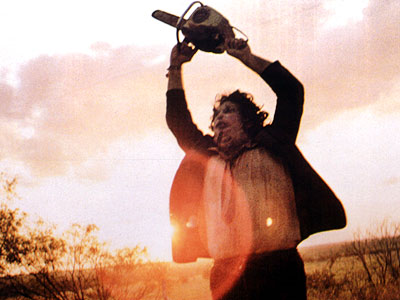 Does young Will mean blood? Does young Will mean blood?
.
Rally to Defend Tasmania’s World Heritage in the Upper Florentine!
.
When: Sunday, 27 April 2014
Time: 12 noon for 12:30pm start
Where: Camp Flozza, In Tasmania’s magnificent Florentine Valley World Heritage Area, Gordon River Road, 21 km east of Maydena
(From Maydena drive along Gordon River Road, heading towards Lake Pedder. On the right, 3.3 km from the Thumbs Lookout, there will be signs for rally).
.
Tasmanians and Australians this is your time!
The Bob Brown Foundation is hosting a rally in World Heritage listed forests of the Upper Florentine, Tasmania, in response to the Australian Government’s intention to remove 74,000 ha from the Tasmanian Wilderness World Heritage Area.
Speakers include Senator Christine Milne – Leader of the Australian Greens, Peg Putt – CEO of Markets for Change and Miranda Gibson – spokesperson for Still Wild Still Threatened.
Bob Brown Foundation Campaign Manager Jenny Weber said, “Tasmania’s globally significant World Heritage Area is gravely threatened by the Australian Government’s request to the World Heritage Committee to remove 74,000ha of forests from World Heritage listing. We are receiving huge support from members of the public who are coming along to this rally, people who love these forests and don’t want to see the listing stripped from forests which have outstanding universal values.”
“We will stand together in the magnificent World Heritage listed Upper Florentine forests to support the world heritage convention and call for protection of Tasmania’s Wilderness World Heritage Area and the maintenance of the current boundary. Standing together among the ancient tall eucalyptus forests, we will prove that the Australian Government is wrong in claiming that it is logged and degraded,” Jenny Weber said.
“The Upper Florentine is pristine. This entire region is proposed for removal from the World Heritage Area, though it is a perfect contradiction of the Liberal Government’s claims that these 74,000 ha are logged or degraded. The Upper Florentine is an extensive area of pristine tall eucalypt forest, part of a corridor of tall eucalyptus forests from the far south to the central west of Tasmania, recognised as World Heritage in 2013. This intact region of ancient forest is again under threat by the Australian Government’s proposal to remove these magnificent intact forests for logging,” Jenny Weber said.
World Heritage Campaign Manager
The Bob Brown Foundation
[Source: ^http://www.bobbrown.org.au/rally_to_defend_world_heritage]

.
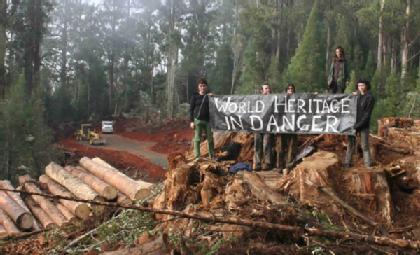 Sacred Upper Florentine Valley being logged only a few years ago Sacred Upper Florentine Valley being logged only a few years ago
.
For Tasmanians, Tasmania is all we’ve got.
.
Tags: Bob Brown, Camp Flozza, economic renewal, Forest War, Forestry Tasmania, loggers, logging trucks, Pulp Mill, Tasmania, Tasmania Police State, Tasmania’s World Heritage, Tasmanian Forest Agreement, Tasmanian Police, Upper Florentine Forest, Upper Florentine Valley, Viking Mandate, Will Hodgman, wood chip
Posted in Tasmania (AU), Threats from Deforestation, Threats to Wild Tasmania | 1 Comment »
Add this post to Del.icio.us - Digg
Leave a Reply
You must be logged in to post a comment.
March 31st, 2014
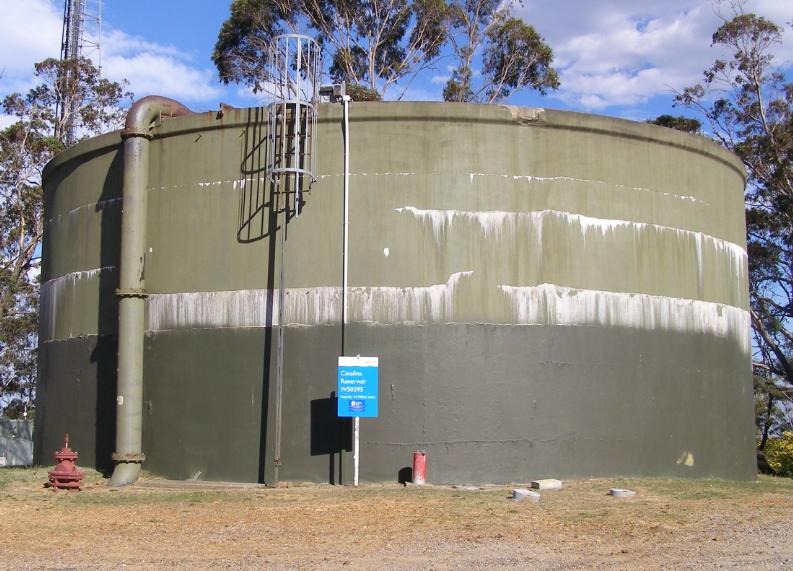 Sydney Water reservoir half-painted
Narrow Neck Road, Katoomba
[Photo by Editor, 20131213, Photo © under ^Creative Commons] Sydney Water reservoir half-painted
Narrow Neck Road, Katoomba
[Photo by Editor, 20131213, Photo © under ^Creative Commons]
This water reservoir tank is one of two on the ridgetop at Narrow Neck Road, Katoomba (Central Blue Mountains, New South Wales) which supplies drinking water to the immediate and surrounding residents of Katoomba.
Previously, in May 2013 we took a photo of both tanks showing the white chlorine salt efflorescence stains and we published an article later in August that year. Why then should someone wish to paint over the stains with green paint? Do they think it will make the water cleaner and more appealing to be drunk?
In our previous article on this topic we asked: “Are we to now expect fresh green paint over the chlorine salt efflorescent tanks to hide the problem?” It seems Sydney Water has done just that. Who else would spend their own money to paint over a government water tank? Why is it that Sydney Water’s water quality analysis measured at the upstream Cascade Reservoir and not from these tanks before it flows to residents?
This is the analysis:
[Source: ‘Typical drinking water analysis’, Cascade Water Supply System, Sydney Water, undated (so supposedly indicative), ^http://www.sydneywater.com.au/web/groups/publicwebcontent/documents/document/zgrf/mdq0/~edisp/dd_044721.pdf]
This is the same tank previously in May 2013:
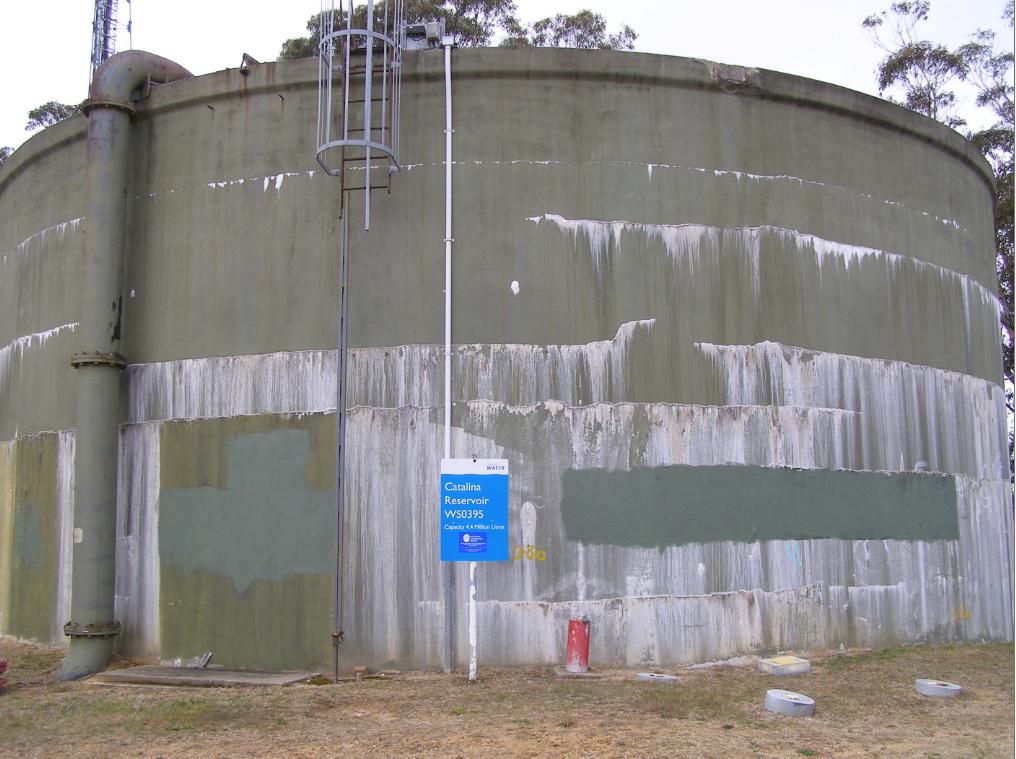 Blue Mountains drinking water tank with chlorine salt stains
Mineral salt efflorescence
Narrow Neck Road, Katoomba
[Photo by Editor, 20130507, Photo © under ^Creative Commons] Blue Mountains drinking water tank with chlorine salt stains
Mineral salt efflorescence
Narrow Neck Road, Katoomba
[Photo by Editor, 20130507, Photo © under ^Creative Commons]
.
This is our previous article:
.
.
Leave a Reply
You must be logged in to post a comment.
|
|
 Katoomba residents Maureen and Peter Toy with Glenn Humphreys (right) marvel at Katoomba’s largest native tree
[Photo © Friends of Atlas, 20140907, click image to enlarge]
Katoomba residents Maureen and Peter Toy with Glenn Humphreys (right) marvel at Katoomba’s largest native tree
[Photo © Friends of Atlas, 20140907, click image to enlarge]
 Sulphur-crested Cockatoo (Cacatua galerita)
These character parrots may be of ‘Least Concern’ to IUCN, but to the clan of cockies habitating Atlas, this is their home.
[Source: Zoos Victoria, ^http://www.zoo.org.au/healesville/animals/sulphur-crested-cockatoo]
Sulphur-crested Cockatoo (Cacatua galerita)
These character parrots may be of ‘Least Concern’ to IUCN, but to the clan of cockies habitating Atlas, this is their home.
[Source: Zoos Victoria, ^http://www.zoo.org.au/healesville/animals/sulphur-crested-cockatoo]






































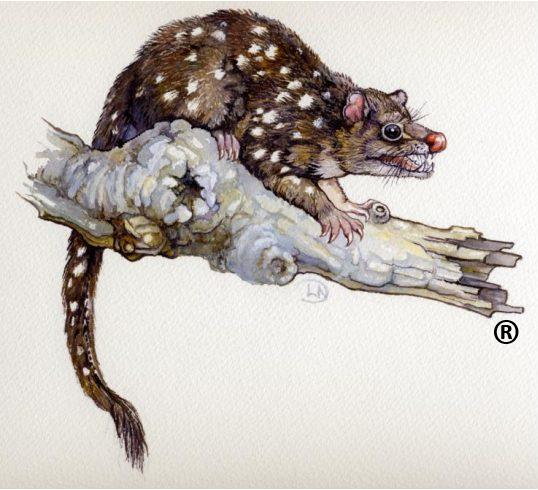
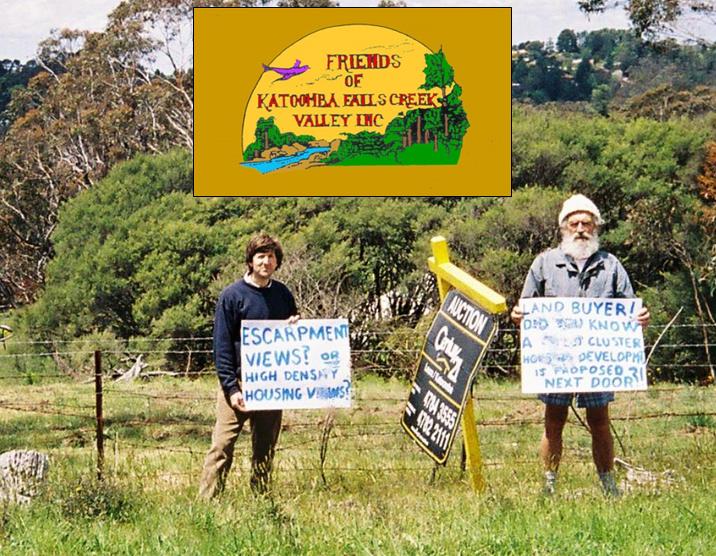
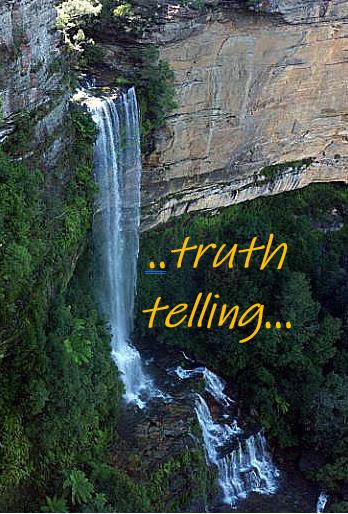
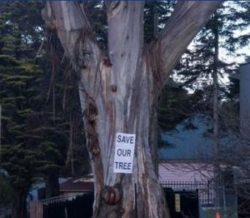
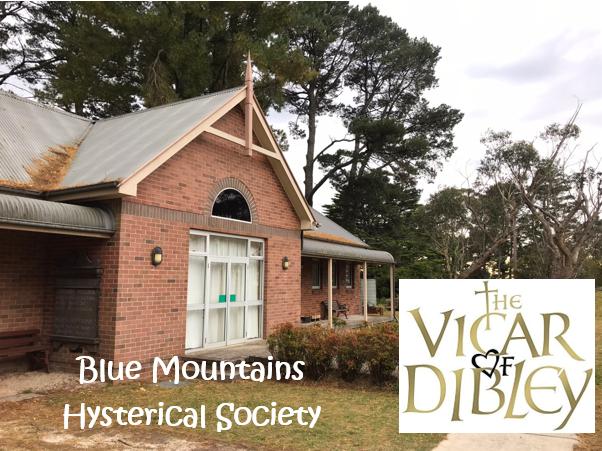

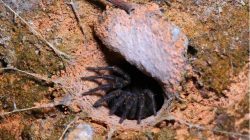

It is very good that you publicized both Jonathon Moylan’s heroic stand against Whitehaven Coal and the hypocrisy of ASIC, ANZ Bank and government’s policy – I find it tragic that in spite of the reality that we are part of the natural environment and dependent on its ecosystem services for our livability and very existence and that the value of these services, as estimated by scientists and economists, exceeds by far the gross domestic products of our economy, we still continue to ignore these fundamental truths and prioritize mining, industry and growth over the essential benefits we receive free of charge from the natural environment and its ecosystem services.